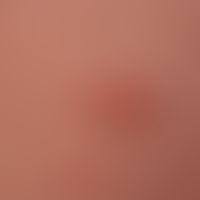Image diagnoses for "Torso", "Nodules (<1cm)", "red"
109 results with 274 images
Results forTorsoNodules (<1cm)red

Pregnancy dermatosis polymorphic O26.4
PEP. Severe itching, red papules on the trunk of a 26-year-old pregnant woman in the 3rd trimester.

Lichen planus classic type L43.-

Gianotti-crosti syndrome L44.4
Acrodermatitis papulosa eruptiva infantilis. disseminated standing, partially eroded papules in an 18-month-old infant. HV only to be assessed in the context of the overall picture.

Mallorca acne L70.8
acne, majorca acne. single papules. round papules with ectatic papillary capillaries. in the surroundings numerous equally sized round sweat gland ostia in sun-tanned skin.

Early syphilis A51.-
Syphilis early syphilis: papular syphilide. No itching. Generalized lymph node swelling. Syphilis serology positive.

Syphilide papular A51.3
Syphilide, papular: multiple, disseminated, dense, small, reddish papules and nodules on a tanned integument in a 67-year-old patient; distinctly palpable, non-painful axillary and inguinal lymph nodes.

Transitory acantholytic dermatosis L11.1
transient acantholytic dermatosis. detail enlargement from previous overview. initial papules, about 1-2 mm in size, deep red with slightly eroded, occasionally scaly surface, characterize the picture. in addition, older plaques (top right) resulting from confluent papules with slight marginal scaling are visible. the nikolski phenomenon is negative.

Lichen planus exanthematicus L43.81
Lichen planus exanthematicus. 4 months old, distinctly itchy exanthema with pinhead-sized, slightly raised, partly isolated, but also aggregated to larger plaques, smooth, shiny, red papules. Streaky arrangement of the efflorescences in scratch or rub marks (Koebner phenomenon; seeleft half of the buttocks).

Transitory acantholytic dermatosis L11.1
Transitory acantholytic dermatosis (M.Grover): detailed picture

Early syphilis A51.-
Syphilis acquisita: papular, completely asymptomatic (recurrent) exanthema (no itching) Important: generalized lymphadenopathy.

Acne (overview) L70.0
Acne vulgaris: numerous follicular inflammatory papules, eroded and ulcerated papules, scars and comedones.

Keloid acne L73.0

Drug exanthema maculo-papular L27.0

Sweet syndrome L98.2
Dermatosis, acute neutrophils: reddish-livid, succulent, pressure-dolent, infiltrated, solitary and partly confluent papules, which confluent to plaques. 1 week before the onset of the disease a fever attack with temperatures > 38 °C occurred.

Varicella B01.9
Varicella: generalized exanthema; beside an older, already dried vesicle (below) a fresh pustule.








